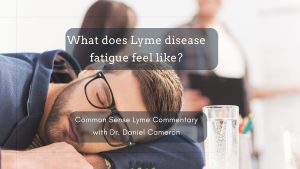Call for your appointment today 914-666-4665 | Mt. Kisco, New York

by Daniel J. Cameron, MD MPH
In the recent Clinical Infectious Diseases article entitled “Long-term follow-up of patients with Lyme disease: Longitudinal analysis of clinical and quality of life measures,” the authors conclude that “both mental health and physical health scores increased to be at or above national average over time, regardless of Lyme disease stage or severity at diagnosis.” [1]
The authors, however, excluded participants with pre-existing comorbidities and symptoms similar to Post-Treatment Lyme Disease Syndrome (PTLDS) from enrollment in the study. [2]
 Samples are biased if they omit any group of people from participating in the study. The exclusion of individuals with PTLDS is an example of an ascertainment bias (omission of affected individuals).
Samples are biased if they omit any group of people from participating in the study. The exclusion of individuals with PTLDS is an example of an ascertainment bias (omission of affected individuals).
Lyme disease patients who enrolled in the NIH-sponsored natural history study were much healthier than patients who enrolled in Lyme disease clinical trials.
Ascertainment bias is the systematic failure to represent equally all classes of cases or people supposed to be represented in a sample.
The quality of life (QOL) for their first visit was 45.6 on their Physical Component Score (PCS) and 47.3 on their Mental Component Scale (MCS) measure of QOL. [1]
The SF–36 summary scores range from 0 to 100, with higher scores representing better self-reported health. The PCS and MCS scores for the normal healthy population is expected to be 50 and 50 respectively. The PCS measures physical functioning (PF), role limitations due to physical health (RP), bodily pain (BP), and general health perceptions (GH). The MCS measures vitality (VT), social functioning (SF), role limitations due to emotional problems (RE), and general mental health (MH).
The QOL for individuals enrolled in clinical trials by Klempner, [3] Fallon [4] and Berende [5] was much lower than for those in the Clinical Infectious Disease (CID) study when evaluating PCS. The PCS was 33, 37 and 31 for the three trials respectively. The PCS for cancer, diabetes and depression are 41, 42 and 45 respectively.
Furthermore, when measuring MCS, the Quality of Life for participants in clinical trials by Klempner, [3] Fallon [4] and Berende [5] was also much lower than those in the CID natural history study. The MCS was 39, 43 and 37 respectively. The MCS for cancer, diabetes and depression are 37, 41 and 48 respectively.
A study by John Hopkins University School of Medicine which included “participants with pre-existing comorbidities and symptoms similar to PTLDS” found the QOL significantly lower. “In this study, baseline scores for PTLDS patients tended to be lower, and were significantly lower than non-PTLDS patients by 6 months,” points out Wills and colleagues from the National Institute of Allergy and Infectious Diseases.
Thirty-six percent of patients suffered from PTLDS in the Hopkins study despite having been treated with a three-week course of doxycycline within six months of treatment. “At 6 months, 36% of patients reported new-onset fatigue, 20% widespread pain, and 45% neurocognitive difficulties,” notes Aucott and colleagues. [6]
The presence of a dramatic difference in QOL between patients in a cohort of Lyme disease patients enrolled in a natural history study at the NIH corroborate a significant ascertainment bias in LD.
This bias might explain why chronic symptoms of LD are dismissed in the Infectious Diseases Society of America’s (IDSA) Lyme disease guidelines. “In many patients, post-treatment symptoms appear to be more related to the aches and pains of daily living rather than to either Lyme disease or a tick-borne co-infection,” notes Wormser of New York Medical College, Valhalla. “Put simply, there is a relatively high frequency of the same kinds of symptoms in ‘healthy’ people.” [7]
As a result of this ascertainment bias, Wills and colleagues miss the point. Chronic Lyme disease manifestations can be severe. Doctors and public health professionals should not dismiss the poor QOL for individuals with Lyme disease based on the natural history study.
References:
- Wills AB, Spaulding AB, Adjemian J et al. Long-term follow-up of patients with Lyme disease: Longitudinal analysis of clinical and quality of life measures. Clin Infect Dis, (2016).
- ClinicalTrials.Gov. Evaluation, Treatment, and Follow-up of Patients With Lyme Disease at https://clinicaltrials.gov/ct2/show/NCT00028080. (Last accessed 4/20/16).
- Klempner MS, Hu LT, Evans J et al. Two controlled trials of antibiotic treatment in patients with persistent symptoms and a history of Lyme disease. N Engl J Med, 345(2), 85-92 (2001).
- Fallon BA, Keilp JG, Corbera KM et al. A randomized, placebo-controlled trial of repeated IV antibiotic therapy for Lyme encephalopathy. Neurology, 70(13), 992-1003 (2008).
- Berende A, ter Hofstede HJ, Vos FJ et al. Randomized Trial of Longer-Term Therapy for Symptoms Attributed to Lyme Disease. N Engl J Med, 374(13), 1209-1220 (2016).
- Aucott JN, Rebman AW, Crowder LA, Kortte KB. Post-treatment Lyme disease syndrome symptomatology and the impact on life functioning: is there something here? Qual Life Res, 22(1), 75-84 (2013).
- Wormser GP, Dattwyler RJ, Shapiro ED et al. The clinical assessment, treatment, and prevention of lyme disease, human granulocytic anaplasmosis, and babesiosis: clinical practice guidelines by the Infectious Diseases Society of America. Clin Infect Dis, 43(9), 1089-1134 (2006).



